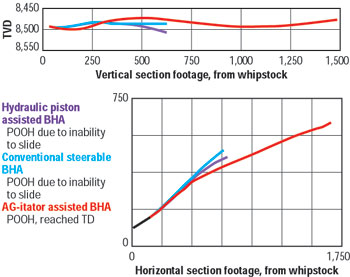 Technology from Europe: Technology from Europe:
United Kingdom
TTRD successfully applied in North Sea well
In June 2002, Shell re-entered one of its North Sea wells using Through Tubing Rotary Drilling (TTRD) to drill a 412-in. drain hole into the Brent sands. Shell had predicted that slide drilling in the depleted Brent sands would be difficult, and had decided to assess a number of technologies to optimize future TTRD campaigns. One of the technologies to be assessed was the 3-3/8-in. Andergauge AG-itator, a drilling tool designed to reduce static friction of the bottomhole assembly (BHA), and improve weight transfer to the bit when sliding a conventional oriented motor.
 |
Fig. 1. A small amount of hydraulic energy is used to agitate the BHA. This action continuously reduces downhole drag and smoothly transfers weight to the bit, irrespective of well tortuosity.
|
|
Already proven in larger tool sizes, this static-friction reducer works by creating a series of pressure pulses, which repeatedly pump open a shock tool, to provide an axial oscillation of the complete BHA, Fig. 1. This movement overcomes the static friction to the wellbore, eliminating weight-stacking problems and resulting in enhanced toolface control, increased weight transfer to the bit and improved penetration rates.
Shell’s intent was to drill down to the reservoir sands before using the new oscillating BHA, but drilling a liner window proved difficult, and a number of openhole sidetracks resulted. While doing nothing for the drilling time curve, these sidetracks provided an excellent comparison of the different BHAs used. After the original hole and two unplanned sidetracks could not slide drill past 600 ft, the new oscillating BHA was selected to maximum effect.
Four sidetrack attempts. For the purposes of this article, three BHAs are compared when assessing the performance of the new BHA oscillator, since two of the four BHAs were the same.
BHA 1 - Directional motor and conventional, hydraulic-piston-type device.
BHA 2 - Directional motor only, with no assisting device
BHA 3 - Directional motor with new BHA oscillator (AG-itator).
BHA 1 achieved 684 ft and drilled from 10,085 ft to 10,767 ft (Heather and Brent formations). The Brent formation top was estimated at 10,645 ft, and at this point, the BHA began to show a rotary drop tendency. Slide drilling was required to correct this trend, and at 10,754 ft, it became increasingly difficult to slide. Weight stacking, motor stalling and differential sticking tendencies were all observed. Another 14 ft was drilled in rotary mode before another slide was attempted. It proved impossible to slide in the Brent formation and the decision was taken to POOH.
BHA 2 (motor only) achieved 415 ft and drilled from 10,353 ft to 10,768 ft with the top Brent coming in at 10,750 ft. On entering the Brent Group, the rotary-mode ROP dropped by 10 – 15 ft hour, and it proved impossible to slide the BHA when oriented.
BHA 3 (BHA new oscillator) achieved 1,452 ft and drilled from 10,200 ft to TD of the well at 11,652 ft. Top Brent was estimated at 10,764 ft. Although the ROP dropped in the Brent formations, slide drilling was possible with good toolface control and minimal sticking tendencies to 10,950 ft. At a depth of 10,950 ft, pressure spikes were observed that periodically interfered with the MWD signal. This coincided with reduced ease of sliding, and overpulls of 20 – 30 klb were noted when picking up after toolface orientation. The MWD system confirmed that the new BHA oscillator was still generating a 24-Hz signal, consistent with the drilling flowrate, but the magnitude of the pressure pulses generated was reduced. Eventually, sliding became impossible but, due to the improbability of relocating this fourth hole, Shell had already elected to sacrifice the BHA and not trip to renew it. Everyone was comfortable with the integrity of the BHA and, therefore, rotary-mode drilling was used to drill the well to TD.
 |
Fig. 2. Comparison of three methods of attempting to slide drill within the Brent.
|
|
Conclusion. Reports from rig personnel are supportive of the benefits provided by the new BHA oscillator. Even in the Heather formation, instantaneous ROPs (in slide mode) of 100 ft/hr were achieved with the BHA oscillator, compared to 60 ft/hr without. In the Brent formation, sliding was possible with good toolface control and minimal sticking tendencies. With the new BHA oscillator working efficiently, no overpull was evident after stationary orientation points. At measured depths over 10,950 ft, up to 25-klb overpull was required to get free after orienting the toolface.
| |
Slide Drilling in the Brent |
|
| |
BHA No. |
Slide footage |
Slide ROP |
|
| |
1 |
Unable to slide |
0 |
|
| |
2 |
Unable to slide |
0 |
|
| |
3 with oscillator |
98 ft |
13.80 ft/hr |
|
|
It would appear that the reduced ability to slide toward the end of the run was due to decreased performance of the BHA oscillator, but, since the tool was sacrificed and remains downhole, it was impossible to ascertain the true reason.
Lack of ability to slide toward the end of the run should not detract from the success, and Shell concluded that future TTRD projects will use the new BHA oscillator from the start. This conclusion has been written into the ABC guide, and other operators, notably BP, have adopted the new BHA oscillator, the AG-itator, for TTRD and coiled tubing drilling. 
|

 Technology from Europe:
Technology from Europe:


